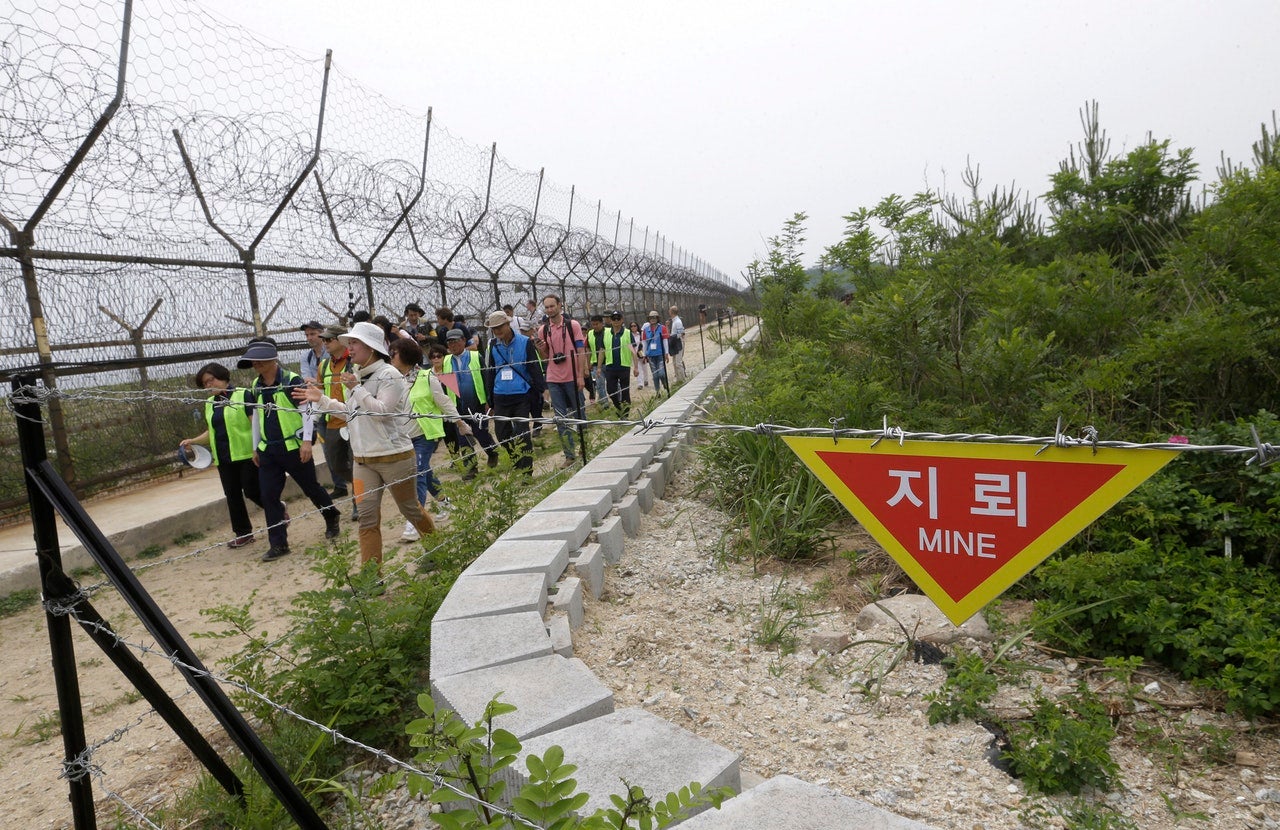
The DMZ seperates North and South Korea. Here’s everything you need to know about the Demilitarised Zone, where US President Donald Trump today met North Korean leader Kim Jong Un. It may be the most heavily fortified strip of land in the world and serves as an uneasy and occasionally bloody borderline between the two Koreas.
However, there is not much demilitarised about it: A minefield laced with barbed wire, it is guarded by combat-ready troops on both sides and has been the site of numerous, sometimes deadly gun battles and skirmishes.
US presidents and other top officials have often travelled to the DMZ to reaffirm their commitment to the defence of ally South Korea in times of hostility with North Korea.
If Mr Kim accepts Mr Trump’s offer for a cross-border handshake, the most likely spot inside the DMZ where the two can meet is the Korean border village of Panmunjom.
Last year, Mr Kim stepped over into the southern side of Panmunjom for a summit with South Korean President Moon Jae-in, becoming the first North Korean leader to set foot on South Korean land.
Here is a look at a border that could once again be a part of history:
Origin of the DMZ
The DMZ, which runs across the Korean Peninsula, is 154 miles (248km) long and 2.5 miles (4km) wide. It was created as a buffer at the end of the 1950-53 Korean War, and is jointly overseen by the American-led UN Command and North Korea.
Hundreds of thousands of North and South Korean troops are now deployed along the DMZ, which is littered with an estimated two million mines, tank traps, razor wire fences and guard posts.
It’s extremely rare for anyone to cross the DMZ in unauthorised areas. More than 30,000 North Koreans have escaped to South Korea for political and economic reasons since the war’s end, but mostly via the North’s long, porous border with China.
Violence was more common during the Cold War, but a 2015 land mine blast blamed on North Korea maimed two South Korean soldiers and pushed the rival Koreas to the brink of an armed conflict.
As relations improved last year, Mr Kim and Mr Moon agreed on several deals aimed at reducing animosity at the border.
They removed mines from certain areas, dismantled some of their guard posts and halted frontline live-fire exercises.
Experts say tensions could easily return if diplomacy eventually fails to end the North Korean nuclear stalemate.
Panmunjom
If Mr Trump is going to meet Mr Kim inside the DMZ, Panmunjom is the most likely place.
It has been the venue for past high-level talks; it is somewhat safer than other areas, and it is just an hour’s drive from Seoul, where Mr Trump will meet Mr Moon.
Most past DMZ visits by US presidents and other officials happened at Panmunjom and nearby areas.
North and South Korean troops stand just yards away from each other there. They once carried pistols, but since last year’s deals they are not armed.
Panmunjom is also where an armistice was signed to stop the Korean War. That armistice has yet to be replaced with a peace treaty, leaving the Korean Peninsula in a technical state of war. About 28,500 American troops are still stationed in South Korea.
Panmunjom is 32 miles (52m) north of Seoul and 91 miles (147km) south of Pyongyang.
Since the armistice, more than 830 rounds of talks have been held in various Panmunjom conference rooms.
Panmunjom is where, during his first summit with Mr Moon in April 2018, Mr Kim stepped across the concrete slabs that form the military demarcation line and the leaders shook hands.
Mr Kim then took Mr Moon’s hand and led him back across the borderline into the North, where they posed for a photo together before returning to the South for a summit.
Before that, the most famous incident at Panmunjom happened in 1976, when axe-wielding North Korean soldiers killed two US officers sent out to trim a tree that was obstructing the view from a checkpoint.
Washington sent nuclear-capable bombers toward the DMZ in response.
Animosities eased after then leader Kim Il Sung, the grandfather of Kim Jong Un, expressed regret over the incident.
In 2017, North Korean soldiers sprayed bullets at a colleague who was making a dash for the border. He survived and now lives in South Korea.
Past presidential visits
In 1993, President Bill Clinton visited Panmunjom when the North Korean nuclear crisis first flared.
In 2002, President George W Bush visited the DMZ a few weeks after he labelled North Korea part of an “axis of evil”.
In March 2012, Kim Jong Un went to Panmunjom and met frontline North Korean troops in his first known visit to the area since taking power in late 2011. He gave the troops rifles and machine guns as souvenirs and ordered them to maintain “maximum alertness”, according to state media.
Days after Mr Kim’s Panmunjom trip and ahead of a planned North Korean long-range rocket launch, President Barack Obama visited a frontline US military camp just south of the DMZ and told American troops they are protectors of “freedom’s frontier”.
In November 2017, Trump planned to visit the DMZ with Moon to underscore his stance on North Korea’s nuclear program, but his plans were thwarted by heavy fog that prevented his helicopter from landing at the border.